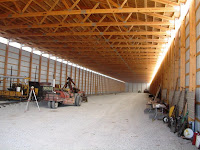
 The seats were installed in a wooden steam road combine at the Mid-Continent Railroad Museum many years ago, so they have been protected from the weather and are in excellent condition. They look nice, but of course are not quite the right size or style for this car. So Mid-Continent has decided to have new seats fabricated to the correct design, and the North Shore seats have been offered to us. The price is $2500 for a set of 23, far less than we would have to spend to make new ones. And then there will be some expense for transportation to Union.
The seats were installed in a wooden steam road combine at the Mid-Continent Railroad Museum many years ago, so they have been protected from the weather and are in excellent condition. They look nice, but of course are not quite the right size or style for this car. So Mid-Continent has decided to have new seats fabricated to the correct design, and the North Shore seats have been offered to us. The price is $2500 for a set of 23, far less than we would have to spend to make new ones. And then there will be some expense for transportation to Union.We can use some of these seats now to replace damaged upholstery in the 160 and 714, and the rest will help with 251 and 253, which we may want to restore at some point in the future.
Of course, you can help. Your donations now will help make this possible. If you're a North Shore fan, or have ever ridden a North Shore car, please give generously.
 We'll be paying for this out of the restricted fund for car #763, so please mark any donations for R763. Thanks!!!
We'll be paying for this out of the restricted fund for car #763, so please mark any donations for R763. Thanks!!!Update: We now estimate the transportation cost at $200, for a rental truck one-way. The move will be taking place on Saturday, Nov. 19th, so we would like to have any donations by then. Thanks!
Update: John Horachek has informed me that these seats came from car 165, in about August of 1963. At that time he was in charge of coordinating the various museums in acquiring cars and parts, and directed the Mid-Continent guys to the 165. Since there was no scrap value in the seats or frames, they were given away for free. And he points out that we could have bought a lot more stuff with our $2500 back in 1963!




















 Work recently took me to Tyler, Texas, the county seat of Smith County. The town is located at the crossing of the St. Louis Southwestern Railway's (also known as the Cotton Belt) mainline and a line of the Missouri Pacific Subsidiary International Great Northern Railroad. The depot is an attractive structure, constructed out of brick, with a tile roof. A local model train museum is located in the freight house portion of the depot. The main portion of the building houses the offices of the local transit authority.
Work recently took me to Tyler, Texas, the county seat of Smith County. The town is located at the crossing of the St. Louis Southwestern Railway's (also known as the Cotton Belt) mainline and a line of the Missouri Pacific Subsidiary International Great Northern Railroad. The depot is an attractive structure, constructed out of brick, with a tile roof. A local model train museum is located in the freight house portion of the depot. The main portion of the building houses the offices of the local transit authority. Hanging on the depot wall was the original Arrival and Departure board. The Cotton Belt wasn't really known for its passenger service. Everywhere it went, the Missouri Pacific went, usually faster and with better equipment. The Cotton Belt went freight only through Tyler in 1956 and ran its last passenger train in 1959.
Hanging on the depot wall was the original Arrival and Departure board. The Cotton Belt wasn't really known for its passenger service. Everywhere it went, the Missouri Pacific went, usually faster and with better equipment. The Cotton Belt went freight only through Tyler in 1956 and ran its last passenger train in 1959.






























